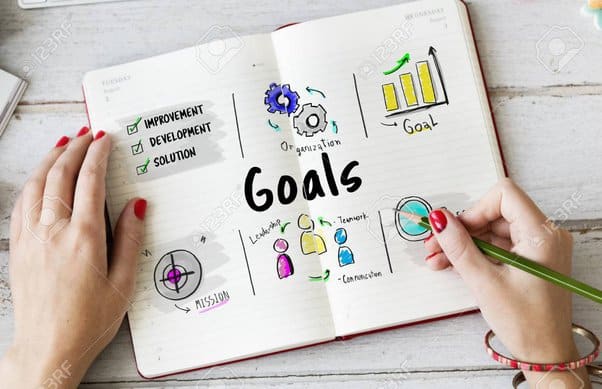Setting professional goals might help you advance as you learn new skills and earn more. From incremental, day-to-day enhancements of your existing work to substantial, long-term plans for a complete overhaul of your professional life, there is no shortage of examples of goals that may be applied to every field. Taking a look at these successful people’s professional goals such as being a teacher, and engineer will help you figure out what you want to accomplish and how to get there in a reasonable amount of time. Therefore, achieving real results at work requires setting a specific objective. The key is to put in the effort necessary, and this is where goal planning and tracking come in. It’s impossible to make progress in your career without putting in some hard work. Developing your professional goals and how to write them will be discussed in this guide.
What are Professional Goals?
Professional goals can be defined as a guidepost for what you want to accomplish and where you want to go in your professional life. These goals can be as immediate and actionable as you need them to be to help you today, this month, or even this year. Your professional goals can also be strategic, pushing you toward a second career or long-term goals.
Furthermore, having a clear idea of where you want your career to go and the steps you need to take to get there, as well as the new knowledge and contacts you will need, can be gained through setting and working toward worthy professional goals.
Job candidates often struggle to respond to the age-old interview question “where do you see yourself and your career in five years?” by providing a concrete example of their professional trajectory.
But before you settle on a course of action, you’ll need to make some choices about where you want to end up.
After this is complete, you should establish both immediate and far-off targets to guide your progress. A short-term goal is a target you have set for yourself that you expect to complete within a relatively brief period of time. That could be a few days or a month, but it must not be a year from now.
And you’ll need additional time and strategy to achieve a long-term objective. Long-term professional development isn’t something you can accomplish in a single year or even a single week. In addition, you have set this as a long-term objective.
Examples of Professional Goals
Here are some top examples of professional goals.
#1. Get Some Brand-New Abilities
As your career develops, you may find that you need to acquire new skills. How, where, and why you work all play a role in determining which skills you should hone. In 2021, cloud computing, artificial intelligence, SQL data analysis, management, and UX design will be in demand.
Do you have no idea where to begin? Talk to your supervisor and see if they have any ideas. Moreover, you can go through job descriptions for positions that interest you; the typical talents indicated will give you an idea of what is in demand in your sector. Find out what you want to know and what will help you excel at work online.
Also, attend seminars, be an apprentice with an experienced worker, or return to school full-time to gain field experience. What works best for you will depend on your goals, available time, and current level of knowledge.
#2. Create an Image of Authority
You should put considerable thought into this common career objective, as it is not always straightforward to pin down. To every one of us, it has a unique significance. What “it” is and who has access to it can be determined by the prevailing values of the company.
Developing an executive presence can help you succeed in any professional setting, whether you’re aiming for a higher position of authority or just looking to sharpen your existing abilities.
Try writing down what you respect most about a person who has an executive presence that you can think of. This can help you establish your executive brand, but be sure to make it your own.
#3. Effortlessly Handle Conflict
In times of enormous unpredictability, it is human nature to look for a rock to steady oneself on. It’s futile to fight or direct change or to go outside yourself for answers and direction. When you learn to adapt to new situations and circumstances and capitalize on your abilities, you gain the confidence you need to successfully move on in the face of whatever change, transformation, or uncertainty may lie ahead.
Understanding what you can change and what you can’t is also useful. Give your whole attention to the second and third groups.
#4. Explore Other Professions
It’s possible that you’d like to make something totally different in your life’s work. Changing your line of work could bring you increased personal fulfillment, better financial rewards, and fresh professional possibilities. Think about your ideal profession and the steps you can take from where you are now to get there. If you have contacts in other fields, it’s worth seeing if any of them may be a suitable fit professionally.
#5. Enhance Your Ability to Manage Time
This is, maybe more than any other objective, the goal shared by all competent people. Get control of your schedule by scheduling time for thinking and determining whether to attend every meeting. Also, set priorities, delegate responsibilities, and develop your career to improve your communication and social skills.
#6. Look for a Role Model
A mentor can help you succeed in your professional life and reach your full potential goals.
The search for a mentor may appear daunting at first but be assured that many others have gone before you. For those who may benefit from learning from a more seasoned colleague, some companies provide mentoring programs. As an additional resource, your professional ties could prove useful. You can begin by joining a professional organization or an alumni network and seeking out individuals whose professional experiences are most similar to your own. Instead, if applicable, reach out to a colleague you believe can serve as a mentor.
#7. Develop Some Innovative Thoughts for Productivity
You may improve your productivity and lay the groundwork for future success in your career by establishing some new, more beneficial routines in your work life. So that you might go up the ranks at your writing firm, you might, for instance, make it a habit to write one more piece every day. If you want to further your career and improve your chances of getting hired, adopting certain new behaviors can help.
What Should I Say for Professional Goals?
Listing your objectives doesn’t make for a very compelling response. Limit yourself to a couple of major goals, and quickly describe how you intend to achieve them or how they will help your career in the long run. The fact that you have written down your future aspirations demonstrates that you have given this matter serious consideration.
How to Write Professional Goals
A strong professional objective statement is concise and to the point. There are several approaches you might take while writing your own personal statement, however, the stages below can serve as a good starting point:
#1. Take Some Time to Reflect on Your Passions
Knowing your true interests is a crucial step toward achieving success in your chosen field. Everyone has their own unique set of interests and values, so it’s important to zero in on those and figures out how to make them your profession. The subject of one’s passion may not yet be clear to other individuals. If you identify with this group, taking on charity work or freelancing while you figure out your next steps is a great idea.
#2. Be Sure to Check Your Information
If you know what you want from your profession, you can write a statement that gets you there. Given that the requirements for success in any given field can vary widely, it’s smart to take your time learning as much as possible about the specific area in which you hope to work. Also, if you want to become a project manager, you might start by learning about Agile and Scrum.
At this juncture, it could be beneficial to seek advice from a mentor who has already achieved success along a similar road. Ask them about the steps they took to reach their professional goals, the training they received, the things they did to hone their abilities, and the online support communities they joined for inspiration and motivation. In addition, the advice of a mentor can be invaluable when crafting a statement of professional purpose.
#3. Pose Yourself With Some Serious Inquiries
The following phase is to examine your own values, priorities, and goals by asking yourself some fundamental questions. Your responses to these questions can assist you in writing a more specific and actionable professional objective statement. Depending on how you respond, you may find yourself better prepared to draft a professional objective statement that is highly congruent with achievable goals. Be sure to write down your solutions so you can refer to them later. Some questions to ponder are as follows:
- What led me to realize this vision?
- How will my personal goals and career goals align?
- What tasks or projects do I love being a part of?
- Where do I see myself in five years?
- Where do I see myself in 10 years?
#4. Establish Smart Targets
SMART goals are those that can be easily measured, defined, prioritized, and completed in a reasonable amount of time. This acronym might serve as a guide as you flesh out your career objective statement. While this is one method, there are a plethora of others from which to choose when putting pen to paper. In addition, a definition of the SMART acronym is as follows:
- Specific: Clarity and conciseness in setting your professional goals can help you focus on what you want to accomplish.
- Measurable: Include a measurable metric if you can into your professional goals. These checkpoints are crucial for determining whether the objective has been met or when significant progress has been made.
- Attainable: Setting realistic and attainable professional goals might help you stay on track to accomplish those goals. Evaluate the tools at your disposal to make sure they complement your plans.
- Relevant: Answering these questions can help you develop a professional objective that is in line with your values, interests, and aspirations.
- Time-bound: Professional goal statements benefit from a firm due date. Because this date may be different for each person, it’s crucial to factor in how much time and work it will take to get the desired result.
#5. Create a Strategy
Create a formal plan of action based on your research and understanding of your long-term objectives. Make sure your career goal statement includes specific measures you will take to reach your objectives. Don’t forget to list any prerequisites you may have, including degrees or certificates, specific courses, a mentor, or specific work experience. To become a forensic accountant, for instance, you must first obtain a bachelor’s degree in accounting, then do an internship in the field, and then become certified to work in the field.
#6. Correct as Necessary
Even if you’ve set SMART goals and know, with absolute certainty, what you want out of your profession, things can always alter along the way. Being flexible and open to change is essential when working toward a long-term goal, as you may undergo significant development that necessitates revising your original plan. Every month or year, it’s a good idea to look back on your accomplishments and see whether your interests have shifted. Also, you can still use this time to assess your development, even if your objectives remain unchanged.
Examples of Teacher Professional Goals
Just what is it that you hope to accomplish in your classroom? Making a significant impact on your students’ lives is likely at the top of the list for most teachers.
Of course, teachers of all levels and subjects have a wide range of other common professional goals.
But, it can be challenging to find a quiet moment or two to focus on personal and/or professional goals that might be extremely important to you as a teacher amidst the pressures of running classrooms and instructing those inquisitive — and, yes, frequently distracted — young brains.
Whether you’re a true professional or just getting started, setting and working toward these goals will help you maintain focus, motivation, and efficacy in your teaching. Yet, remember that the professional goals themselves are not what will advance you as a teacher. You’ll become a better teacher not just because of the ideas themselves, but also because of the impact they’ll have on your students if you put them into practice.
By the end of the year, you’ll look and feel drastically different if you keep these goals in mind and make an effort to work toward them every day.
What are the Teacher’s Professional Goals?
Teacher professional goals are targets that teachers establish for themselves to make sure they can manage a classroom full of diverse children while enhancing outcomes that could result in moments that define their careers.
These objectives may concentrate on a variety of topics, such as student achievement, classroom management, instructional practices, and professional development. They are often aligned. These specific goals are significant because they touch on several problematic classroom topics, from inclusion to promoting creativity.
By establishing daily, weekly, and monthly checkpoints for yourself, you will gradually come to the realization that you have accomplished many of the objectives we outline below by the conclusion of the school year.
Examples of Teacher Professional Goals
Here are some examples of teachers’ professional goals.
#1. Improving One’s Teaching Skills
The best teachers are also the ones who recognize the importance of continuing their own education throughout their careers. Throughout your career as a teacher, you should feed your drive to develop through activities like reading and study (like these suggestions on teacher preparation and planning) and attending workshops and other professional development events geared for educators.
Attending educator professional development classes and programs on a regular basis is one of the finest methods to keep learning and growing as a teacher. Professional development courses are available on a wide variety of relevant subjects, such as those listed below.
- Technology in Education
- Reading and Literacy
- Classroom Management
#2. Technology
New teaching methods and technical resources developed to improve students’ education and better prepare them for life in the digital age have a significant impact on the development of education as a whole.
Obviously, technology is present in our lives in various ways, and most contemporary students spend a significant portion of their day staring at a screen. Attempting to resist technological advancement is, of course, fruitless; nevertheless, identifying the productive use of technology in the classroom can have a significant impact on students’ learning.
Several educators are finding that podcasting and using school websites to engage both students and parents are effective uses of technology in the classroom. The free web service Google Classroom is utilized by an estimated 30 million teachers and students worldwide. Google Classroom is a paperless, user-friendly online tool that facilitates assignment creation, distribution, grading, collaboration, quick feedback, and communication between teachers and their students. If you’re a teacher and you’re interested in using Google’s G Suite for Education, you can also become a Google Certified Teacher.
#3. Improve Learning Outcomes by Evaluating Student Progress
Teachers can learn where their pupils are struggling and devote more time and energy to helping them by administering assessments. This data can then be utilized to direct instruction in the areas where students need the most help.
In order to ensure that students are making progress toward their learning objectives, teachers should regularly use assessments to inform both big and little curriculum changes.
In particular, the instructor will have a better idea of whether or not her students are on track to succeed on end-of-year exams if they administer tests on a weekly or monthly basis.
#4. Create a Welcoming Atmosphere in the Classroom
It is essential to create a classroom atmosphere where all children feel safe and supported to ensure that all students learn and grow.
Teachers can help achieve this goal by consciously creating a classroom climate that respects and appreciates each individual student and encourages them to participate fully in class discussions.
Some of the cornerstones of creating an inclusive classroom are fostering healthy connections among students, promoting open communication, and dealing with any difficulties that may occur in a courteous and productive manner. Also, read CLASSROOM MANAGEMENT STYLES: 10 Principles Of Classroom Management.
In a regular school, children are free to share their ideas and opinions, and teachers are interested in their success and actively seek out and welcome the contributions of all students.
There are several ways in which educators can foster a sense of belonging among their pupils, including emphasizing the value of diverse viewpoints and cultural practices and providing students with numerous opportunities to work together on group projects.
Teachers may encourage their pupils to realize their potential by cultivating an environment where they feel safe, appreciated, and respected.
#5. Connect Closely With Your Pupils and Their Families
One of the most important parts of being a good teacher is establishing a positive rapport with your pupils’ families. However, teachers who make an effort to connect with students’ families, and especially their children’s parents, are more likely to develop an encouraging classroom climate.
In the long run, you’ll do your pupils and their families a favor by being approachable, sympathetic, and empathetic to their needs.
To get closer to your loved ones, you could try keeping in touch with them more often. However, if you listen to students, offer help, and keep your door open, you can help them succeed.
Furthermore, teachers may do more to encourage parental involvement in their student’s education by planning and executing events and activities that bring parents and children together. One tried-and-true strategy for maintaining family involvement is to keep them informed about their student’s academic development and accomplishments.
#6. Encourage Reflection and Group Work
Helping kids learn to think independently and critically is essential if they are to become independent problem solvers in the future.
The best way for students to internalize classroom knowledge and use it in the real world is for teachers to design learning activities that provoke critical thought about key concepts.
Students will be best ready to transfer their knowledge learned in the classroom to the real world through critical thinking if they are given the opportunity to do so through a variety of hands-on activities, field excursions, dialogues, and simulations where there is more room for play.
It also includes opportunities for pupils to work together on projects with their classmates. Given that teamwork is essential to so much of what we accomplish in the real world.
#7. Master, the Art of Leading a Classroom Effectively
Effective administration of a classroom can make it a pleasant place to learn where everyone feels secure. However, to effectively manage a classroom, teachers must establish routines and procedures, establish clear expectations for student behavior, and cultivate a classroom climate that acknowledges and responds to students’ emotional needs.
Also, any classroom’s performance depends on the teacher’s ability to manage their duties and implement successful management strategies.
This may require the use of both preventative measures, such as the establishment of consistent routines and expectations, and corrective measures, such as the redirection of undesirable or disruptive behavior. Also, having these abilities can assist teachers to encourage learning and academic success for all their pupils.
Why Are Professional Goals Important?
Setting goals for an entire company might be difficult if the company is large and there are many employees to consider. Despite the best of intentions, too little follow-through occurs beyond the first flurry of activity surrounding the creation and development of such goals. When objectives are well-aligned, they instill a feeling of meaning in both the company and its members. A person or organization may figure out how to get there if they have a clear aim and rationale. So, here are some reasons why professional goals are important.
#1. Enhance Your Current Set of Abilities in the Workplace
There is always room for growth and development, no matter how skilled you already are. The best athletes don’t just sit back and coast on their present fitness level for the remainder of their careers. Instead, they commit time to train on a regular basis to increase their physical prowess. It’s the same in the workplace: putting in the time to improve your existing abilities will help you develop new ones, making you a more valuable employee and paving the door for greater career success.
#2. Increase Efficiency
Having something to work for can give a constant source of inspiration and increase output on the job. This is especially the case if you break your objectives down into manageable chunks and aim to finish one chunk per day or week. Even if it’s only a little bit, it’s still progress, and progress is what keeps you going.
#3. Strengthen You to Be a More Reliable Employee
In the workplace, employees who are passionate about their work and their careers are extremely valuable to their employers. If you spend time learning and improving your job skills, your boss will notice and may even promote you.
What Are Tips for Setting Professional Goals
Here are some tips for setting professional goals.
#1. Using a Bottom-up Strategy
Setting goals from the bottom up has been shown to improve participation, comprehension, and motivation among workers. Workers who have a hand in formulating organizational objectives are more likely to take ownership of those objectives and work to see them through to fruition. However, for employees to better understand how their individual efforts contribute to the larger aims of the company, managers and HR professionals can work together to define metrics. Also, this is the starting point from which important conclusions can be drawn.
#2. Relating Personal Aspirations to Larger Corporate Objectives
Especially in the modern workplace, where people are looking for deeper meaning in their work, employees who view their employment just as a series of tasks to be completed are likely to get frustrated and leave their positions. If workers know how their efforts contribute to the company’s success, they will be more invested in their own professional development. When employees’ goals are aligned with those of the company, they take on more responsibility. They are more invested in seeing results now that they know how their efforts will affect the whole because of this.
#3. Gratitude for Successes, Big and Small
Acknowledging employees who meet or surpass targets encourages healthy competition. By instituting even a basic system of recognition—a round of applause for a positive customer review, a gift card for achieving a key result or a challenging target, a meeting and bonus for completing the project under budget, etc.—you can send a clear message to your staff that their efforts are appreciated and rewarded. If an employee’s skills and efforts aren’t recognized, it may send a message to other employees that their efforts are for naught. In addition, managers can speed up the recognition process with the right technology.
#4. Developing Employees Into Superior Individuals
Employees are just as important as the goals and deadlines they’re tasked with meeting. Managers that care about their teams’ long-term performance pay attention to how their employees are doing in terms of accomplishing their objectives. Although it may be difficult in the near term, employees appreciate having a boss that is committed to them and is seen as an advocate for their success. And they’re more likely to suggest courses that others in the company could benefit from taking, too.
Having regular one-on-ones where employees feel comfortable making suggestions on the manager’s management style or the availability of resources is beneficial for the development of all parties involved, including the company they work for.
Conclusion
One of the most important skills a leader can develop is the ability to set meaningful goals. You probably wouldn’t be where you are today if you hadn’t established and accomplished professional goals along the way, but it never hurts to give your professional aspirations a once-in-a-while checkup. Those who aspire to leadership roles should be lifelong learners who are constantly looking for new ways to better themselves.
Professional Goals FAQs
What are the 5 smart goals for work?
The acronym SMART describes the characteristics of effective goals: they are, attainable, important, and time-bound. So, goals that don’t meet all five of these requirements aren’t SMART goals.
What are other helpful resources on goal-setting?
There are several helpful pieces on goal-setting and progress monitoring in Range. Such aids will be useful to your teams:
- The goals and objectives for a team should be SMART.
- Methods for Monitoring Workplace Objectives
- Models of Objective Engineering Results
- The top program for monitoring progress toward objectives
Similar Articles
- BEHAVIOUR MANAGEMENT SYSTEMS: Effective Components, Strategies and Systems
- The Power of a Leader in an Educational Environment
- School Management Software: Top Picks In 2023
- WHAT IS AN LMS: Platforms, Examples & Training






